ADP's proprietary private payrolls jobs report shows a gain of 176,000 private sector jobs for August 2013. ADP revised July's job figures down by 2,000 to 198 thousand jobs. Overall, August shows same ole, same ole in the ADP job figures. This report does not include government, or public jobs.

Jobs gains were in the service sector were 165,000 private sector jobs, again large gains. The goods sector gained 11,000 jobs. Professional/business services jobs grew by 50,000. Trade/transportation/utilities showed strong growth again with 40,000 jobs. Financial activities payrolls increased by 1,000, the lowest increase since June 2012.
Construction work tapered off in the goods sector job growth with 4,000 jobs added. Manufacturing gained 5,000 jobs for the month. Graphed below are the month job gains or losses for the five areas ADP covers, manufacturing (maroon), construction (blue), professional & business (red), trade, transportation & utilities (green) and financial services (orange).
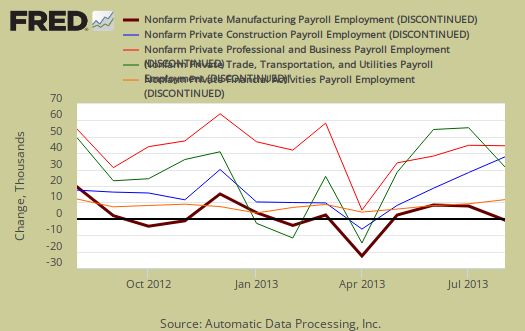
ADP is reporting a stable hiring and this as average job growth of the last year. Steady as she goes was quoted by Moody's. One odious comment claimed manufacturing recovered, uh, no they have not, they reserved their ADP jobs losses from last month.
If one tallies up the ADP jobs by sector reported, financial, construction, manufacturing, professional/business and trade/transportation/utilities, they had up to 100,000 jobs for this month. It appears that ADP does not report on the biggest jobs growth, food and restaurant workers. These are jobs within the service sector and are most often the lowest paying and also part time. Below is a graph of those jobs left over from the ADP employment figures after subtracting off these five sectors: financial, construction, manufacturing, professional/business and trade/transportation/utilities. ADP reports 7.075 million private sector jobs have been added since January 2010. There has been a 2.942 million job gain in those sectors not broken down by ADP. That's 41.6% of the jobs ADP reports as gained where we have no clue on what types or sector gains they are in. For a reference the BLS gives a 7.31 million private sector job gain of the same period.

ADP reports payrolls by business size, unlike the official BLS report and this month growth was across the board. Small business, 1 to 49 employees, fueled the private payroll gains by adding 71,000 jobs with establishments having less than 20 employees adding 40,000 of those jobs. Notice they count businesses with one employee. Medium sized business payrolls are defined as 50-499 employees, added they added 74,000 jobs. Large business added 32 thousand to their payrolls. If we take the breakdown further, large businesses with greater than 1,000 workers, added 27,000 of those large business jobs. Thing is, we do not know if those are American workers or foreign guest workers on Visas and this time of year brings in more foreign workers due to the H-1B Visa issuances earlier in the year. Other metrics showed multinational corporations are not hiring Americans, in the United States.
Below is the graph of ADP private sector job creation breakdown of large businesses (bright red), median business (blue) and small business (maroon), by the above three levels. For large business jobs, the scale is on the right of the graph. Medium and Small businesses' scale is on the left.
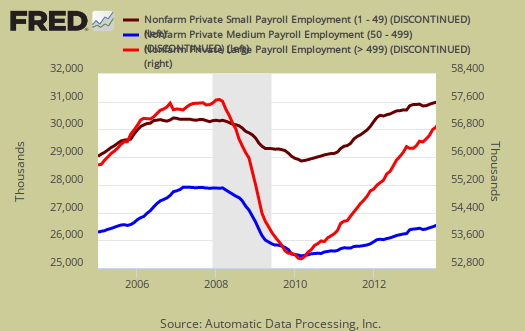
One of the more interesting aspects of the ADP report is the breakdown of the private sector by service producing and goods producing jobs. The service sector are disproportionately lower paying jobs as a whole in comparison to goods producing jobs, even while including the financial, professional and business services sectors are part of services. This month's goods gains might be better news for wages, although the construction industry is notorious for using illegal labor and now has repressed wages. Below is the graph of ADP service sector (maroon, scale left) jobs against their goods production jobs (blue, scale right).

This report, if it matches Friday's official unemployment report, would overall imply overall enough job growth to keep up with population, as this is just the private sector job growth. Government jobs will surely be negative due to sequester, where the effects are still being felt and government has been shedding jobs going on years.. The U.S. needs about 115,000 jobs per month, minimum just to keep up with population growth, with the same lousy, artificially low, labor participation rates.
The monthly BLS jobs survey (CES) has a 100,000 payroll jobs overall margin of error. ADP changed their methodology and now claim to match the BLS private payrolls, but only historically, after revisions. The below graph shows shows how many private sector payroll jobs, each month, ADP was off by in comparison to what the BLS reported. This is a monthly graph, not cumulative. As we can see, it's been rare where the two monthly reports get the exact same private payrolls growth numbers. When the below graph bar is negative, that means the BLS reported a larger number of private jobs than ADP did, when the graph bar is positive, it means ADP reported larger private payrolls. Again, compared are private sector jobs which is different from the BLS headline number. The graph will was updated with Friday's August BLS jobs report.
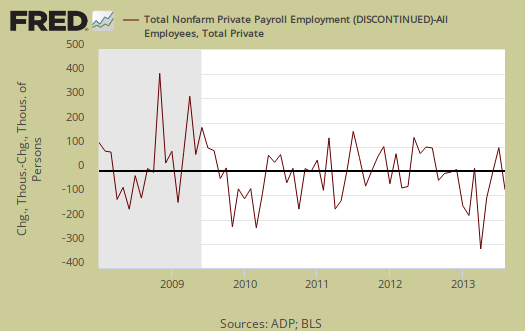
Below is the cumulative difference between what the ADP reports as the private nonfarm payroll jobs vs. the BLS (ADP minus BLS). This line shows the divergence, over time in number of nonfarm private payroll jobs reported between the two reports. Previously the difference between ADP and BLS was around 400,000, now we see the cumulative error more in line with the real BLS CES survey margin of error. Here again we see a massive change in the ADP private payrolls methodology and benchmarking. ADP claims their private payrolls cover 24 million jobs with 416 thousand businesses in the U.S. This represents about 20% of U.S. payrolls. The graph was updated with Friday's BLS private non-farm payrolls data.
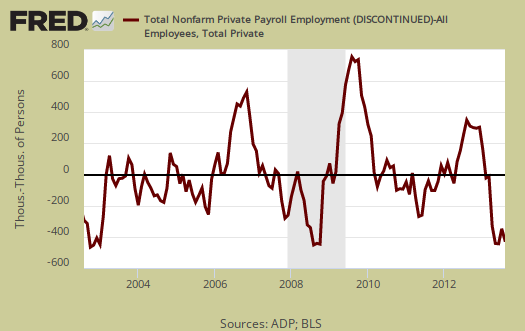
The graph below is the monthly change of private jobs as reported by ADP. At the absolutely bare minimum, the United States needs 1.2 million jobs per year, or 100,000 per month, total jobs, including public sector jobs, to keep up with additional new workers in the labor supply caused by population growth with the current terrible labor market conditions assumed.
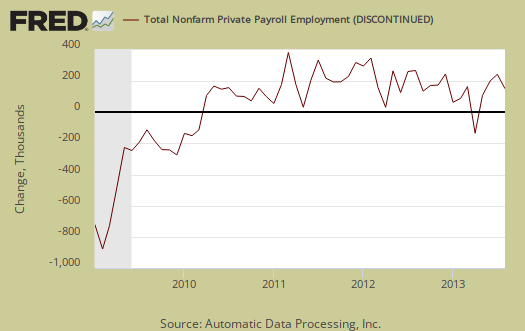
Regardless of the statistical differences between ADP and the BLS, these payroll figures are ok, yet nothing to scream and shout about as usual. Steady as she goes should be analogous to maneuvering a oil tanker with a paddle upstream.
Here is our overview of last month's ADP private sector jobs report overview, only graphs revised. This article goes into the methodology details on the ADP report changes and compares historical data of the two methodologies in graphs.
ADP themselves have really improved the visuals on their website for more perspectives, breakdowns and charts of their statistics.

Recent comments